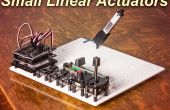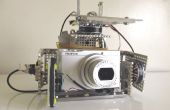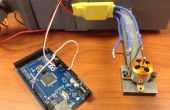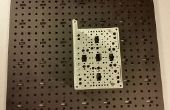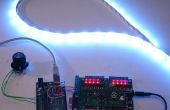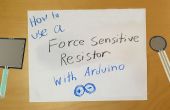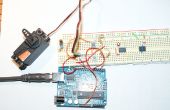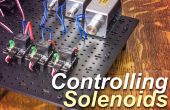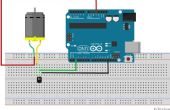Stap 4: Code 2 - Preset positie met behulp van positionele Feedback
Deze code laat zien hoe te doen fundamentele controle van een grote Lineaire servomotor met elke knop voorinstelling naar een positie met behulp van een Arduino en twee knoppen.
U kunt de code schets hier downloaden: https://github.com/robotgeek/largeLinearPresetPositions/archive/master.zip
/* Linear Actuator Control using preset position This demo shows how to do basic control of a large linear actuator using an Arduino and two buttons. Each button is hard coded with a preset position. Pressing a button will move the actuator to that position. The circuit: * RobotGeek Pushbutton - Digital Pin 1 * RobotGeek Pushbutton - Digital Pin 2 * RobotGeek Relay - Digital Pin 4 * RobotGeek Relay - Digital Pin 7 Products Used in this demo: - http://www.robotgeek.com/linear-actuators - http://www.robotgeek.com/robotgeek-geekduino-sensor-kit - http://www.robotgeek.com/robotGeek-pushbutton - http://www.robotgeek.com/robotgeek-relay */ // constants won't change. They're used here to set pin numbers: const int button1Pin = 2; // the number of the pushbutton1 pin const int button2Pin = 4; // the number of the pushbutton2 pin const int relay1Pin = 7; // the number of the Realy1 pin const int relay2Pin = 8; // the number of the Relay2 pin const int sensorPin = 0; // select the input pin for the potentiometer // variables will change: int button1State = 0; // variable for reading the pushbutton status int button2State = 0; // variable for reading the pushbutton status int sensorValue = 0; // variable to store the value coming from the sensor int goalPosition = 350; int CurrentPosition = 0; boolean Extending = false; boolean Retracting = false; void setup() { //start serial connection Serial.begin(9600); // initialize the pushbutton pin as an input: pinMode(button1Pin, INPUT); pinMode(button2Pin, INPUT); // initialize the relay pin as an output: pinMode(relay1Pin, OUTPUT); pinMode(relay2Pin, OUTPUT); //preset the relays to LOW digitalWrite(relay1Pin, LOW); digitalWrite(relay2Pin, LOW); } void loop(){ // read the value from the sensor: CurrentPosition = analogRead(sensorPin); // print the results to the serial monitor: Serial.print("Current = " ); Serial.print(CurrentPosition); Serial.print("\t Goal = "); Serial.println(goalPosition); // read the state of the pushbutton values: button1State = digitalRead(button1Pin); button2State = digitalRead(button2Pin); if (button1State == HIGH) { // set new goal position goalPosition = 300; if (goalPosition > CurrentPosition) { Retracting = false; Extending = true; digitalWrite(relay1Pin, HIGH); digitalWrite(relay2Pin, LOW); Serial.println("Extending"); } else if (goalPosition < CurrentPosition) { Retracting = true; Extending = false; digitalWrite(relay1Pin, LOW); digitalWrite(relay2Pin, HIGH); Serial.println("Retracting"); } } if (button2State == HIGH) { // set new goal position goalPosition = 500; if (goalPosition > CurrentPosition) { Retracting = false; Extending = true; digitalWrite(relay1Pin, HIGH); digitalWrite(relay2Pin, LOW); Serial.println("Extending"); } else if (goalPosition < CurrentPosition) { Retracting = true; Extending = false; digitalWrite(relay1Pin, LOW); digitalWrite(relay2Pin, HIGH); Serial.println("Retracting"); } } if (Extending = true && CurrentPosition > goalPosition) { //we have reached our goal, shut the relay off digitalWrite(relay1Pin, LOW); boolean Extending = false; Serial.println("IDLE"); } if (Retracting = true && CurrentPosition < goalPosition){ //we have reached our goal, shut the relay off digitalWrite(relay2Pin, LOW); boolean Retracting = false; Serial.println("IDLE"); } }
